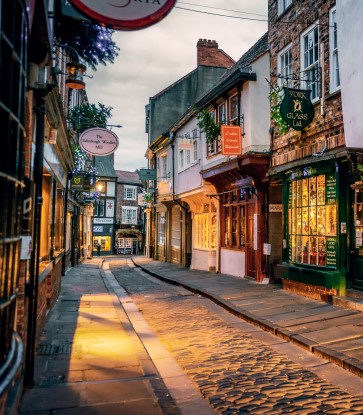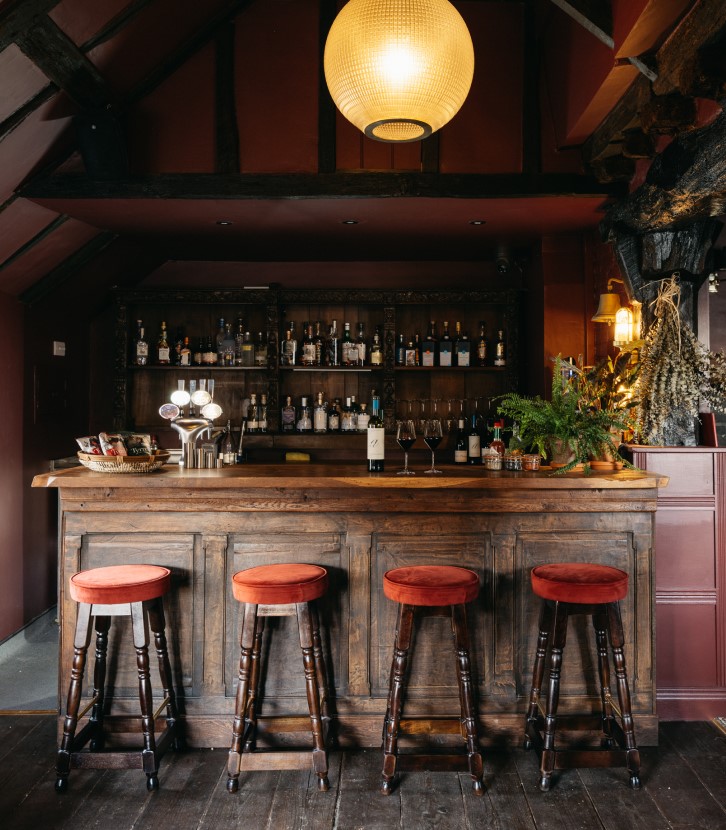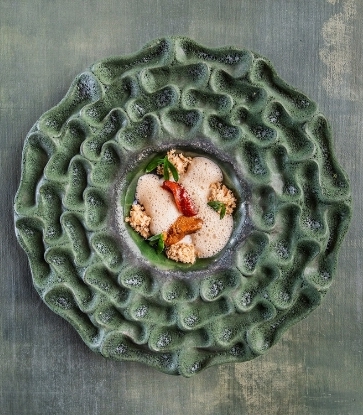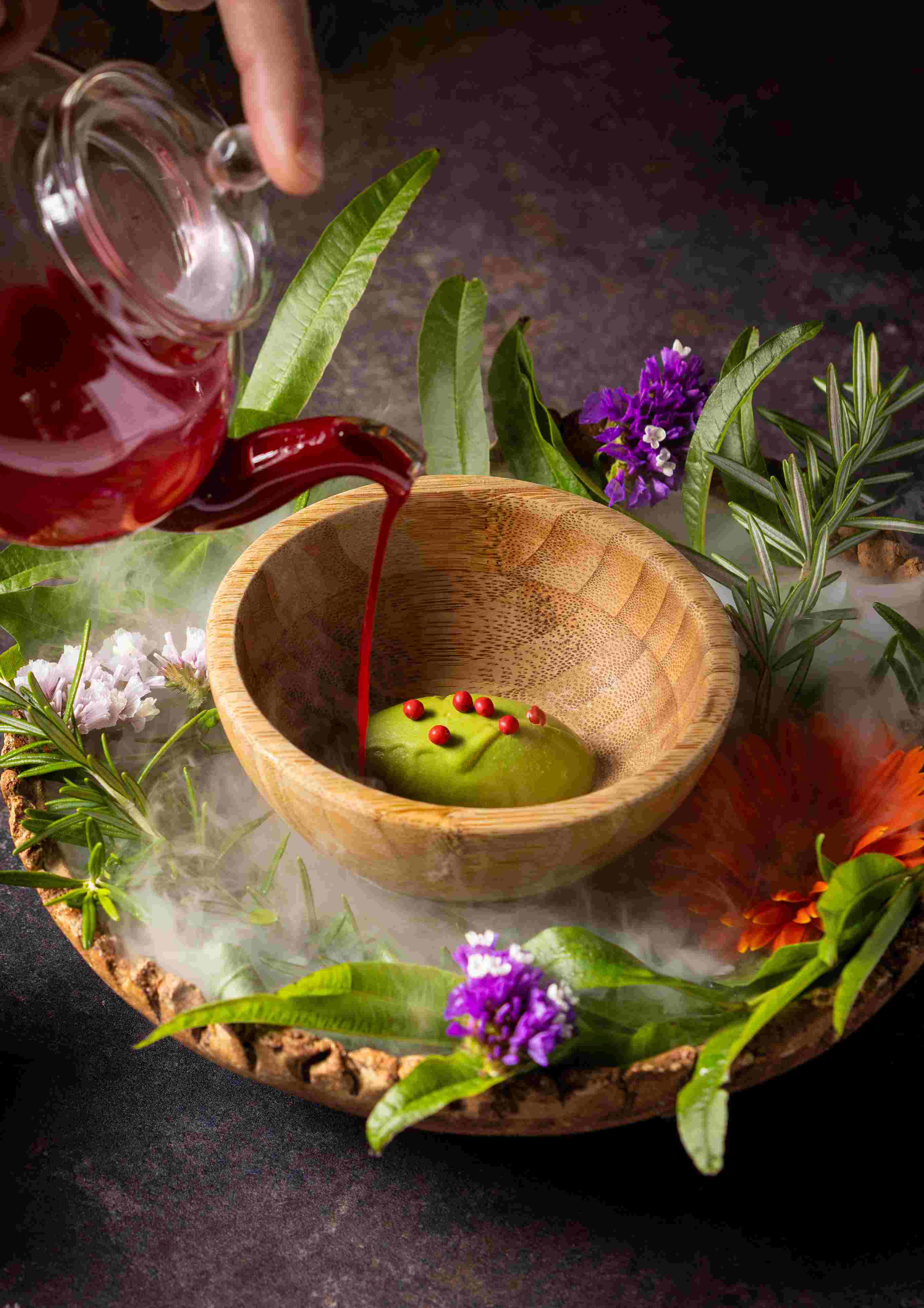A great connoisseur of Japan, Sylvain Sendra is a purist when it comes to the taste of tea, which he associates with quality produce and natural flavours. In 2009, he published a recipe book with Carine Baudy: La Cuisine au Thé (published by Agnès Viénot), which includes dishes such as salmon tartare with an emulsion of Sencha Ariake green tea and julienne of preserved lemons. The chef is a follower of wabi-cha, an aesthetic concept that embraces the humility and simplicity of the ritual of tea. Still customary in Japan today, it has two dimensions: one intangible, in the way guests are received and the atmosphere of the tea tasting session is set up, and the other more pragmatic, in the organisation of the proceedings and the orchestration of the tea service.
Sylvain Sendra talks to us about the special relationship he has with Japan, born of his many trips over the years.

Part 1 : Getting to know Japan and its green teas
What were your first sensations when getting acquainted with Japan?
Did you want to introduce particular elements of Japanese gastronomy into your cooking?
"I am inspired by Japanese working techniques and I work with a Japanese market gardener - Asafumi Yamashita (La Ferme Yamashita, located in Chapet, 78130 Yvelines). In winter, I always see him with a flask nearby, and together we drink a hōjicha: I can drink this tea all day long for its roasted notes, and I combine it with either savoury or sweet flavours. Thanks to him, I get a lot of vegetables of Japanese origin. Japan has been a big inspiration to me in terms of how fish is cooked and how produce is cut – meat and vegetables in particular. I also got a lot of inspiration from Japanese techniques for dressing the plates and for seasoning. Nowadays, it has become a habit in modern French cuisine to insert Japanese ingredients such as nori seaweed and shiitake mushrooms..."
What about green tea during your trips to Japan?
"I first came across it at breakfast and often during work meetings. Soon as you have a business meeting, you drink tea and take part in tea ceremonies. At each meeting with a regional director or a mayor, you are offered a Japanese green tea, a different tea each time. According to the weather and their grade, you get to try quality teas from several regions. Especially sencha. I like to pair Chinese cabbage, turnip and miso sauce with a Japanese green tea."

What are the rituals, the codes that you appreciate?
"When they want to please you, they ask you to participate in a chanoyu: the tea ceremony. I appreciate the flavours of a real tea ceremony because everything is ritualised, codified. For a cook, rigour is important. When they want to show you Japanese culture, they invite you to specific places. It was on those occasions that I became familiar with kaiseki cuisine, which comprises a series of dishes, which can be less numerous if preceding a more specific tea tasting."
Is the method for preparing teas crucial?
"At one point, in my restaurant I was drinking a lot of coffee – and I still do – but to relax myself I would drink Japanese green tea, before and during meal services, in particular. One of the waitresses at that time had worked at the École du Thé and she would prepare the tea to perfection, adhering to brewing times, which is not often the case in France in restaurants. I was speaking to Romain, my maître d', about it this morning, and said to him that we have to be extremely careful when it comes to serving tea, being mindful of the choice of water and steeping method. The paradox is that in France we consume a lot of quality tea, especially green teas, including Japanese teas. But I'm not sure we know how to prepare them properly."
In the company of Gilles Brochard, a journalist specialising in teas, Sylvain Sendra tastes Japanese green teas and gives us his impressions and sensations, as well as valuable advice for tea lovers...

Part 2 : Tasting Japanese green teas
"In terms of flavours, there's a lot to love. Since my earliest trips to Japan, I have been drinking green teas very frequently. I believe that the success of a green tea is mainly down to its quality but also to the person who has prepared it. Because actually I appreciate it when a member of my team serves me a good Japanese green tea; it means I take the time to drink it before the service to relax. In the restaurant I prefer to use good tea bags rather than loose tea. So we have Japanese green tea, especially sencha, because the customers ask for it. But it's mostly connoisseurs who demand it."The importance of water
"It is crucial to use good pH-neutral water to prepare a quality tea. In the restaurant, we use filtered water to avoid lead, lime scale and the taste of bleach that tap water often has in Paris."
During our time together, we prepared each tea the French way with Cristaline, a natural spring water with a pH of 7.5 – not boiling water, but water heated in a thermostat kettle, at the temperature appropriate to each tea tasted.
On the table are Kukicha, Sencha, Gyokuro, Uji Matcha and Genmaicha. Patient and focused, the chef describes the pleasures involved and shares memories of his travels in Japan.
Kukicha
A lot of (light green) stems, which contain fibres, mixed with sencha leaves (darker green). It yields a nice pastel green liquor and exudes a vegetable aroma. Pleasingly refreshing first impression in the mouth. Slight astringency. Some tea lovers appreciate its airiness, which is conducive to the palate meandering from flavour to flavour. It is appreciated all the more insofar as it requires you to achieve a point of balance to obtain the perfect brew. That is when its beneficial properties seem all the more considerable, to the point of bringing the drinker a certain serenity, or even a gustatory plenitude.
Water at 90°C in a kyūsu teapot / 6-8g / steeped for 2 min and served in small transparent cups (white porcelain can also be used). A delicate green colour, with a contrast between the light stems and darker leaves.
"In general, when I drink this type of tea, I prefer more tea and less steeping. After a first steeping, I immediately get an aroma of green grass in the nose. Then I get this sensation of seaweed, characteristic of Japanese green teas, which returns like a second note. It is pleasingly long in the mouth once the cup is finished. The slightly bitter note is not unpleasant. With the second steeping, the liquor appears a little cloudy and the first impression when you taste it is vigorous and the flavour is delicious. Drinking this tea, I understand why I drink less coffee..."
Sencha
The fresh Kyoto sencha we prepared is a classic tea with beautiful uneven leaves and fine needles, including some broken leaves and an intense green colour. We chose to make it quite concentrated so as to be able to take in all of its aromas. We could also have chosen a fukamushi sencha, the leaves of which are steamed for a longer period of time, making them more sensitive to rolling, resulting in more broken leaves. But this classic sencha, which also has broken leaves, is very similar.Water at 70°C in a small, flat Japanese teapot / 5g for 20cl / steeped for 2 min.
"This tea is remarkable, with an herbaceous nose. The liquor must be properly distributed in the small cups to balance out the flavours. The last drops are the best...After the first steeping, you can taste that it's very mellow. I like it when there is some leaf debris left in the cup. It's unavoidable and I don't mind that."

Gyokuro
Our choice was an organic Gyokuro Mizuumi with brightly coloured jade green leaves. Seeing it like this, so vivid, all the properties it can hold come to mind. Very pleasant floral nose.
Water at 50°C in a kyūsu teapot without a lid / 6g / steeped for 90 seconds.
"After the first steeping, you can taste that it's very mild. It calls to mind notes of Jerusalem artichoke, artichoke and seaweed. For me, it is first and foremost these three aromas that make a gyokuro excellent. I like it even more concentrated. It has a nice retronasal smell and I notice that it is not very astringent. Even when it cools down, it is pleasant. The second steeping is more concentrated because there is less water in the pot. The tea has a pronounced sweetness alongside its floral notes. It's a lovely tea, with those lingering artichoke notes, and its pleasingly clean retronasal smell."
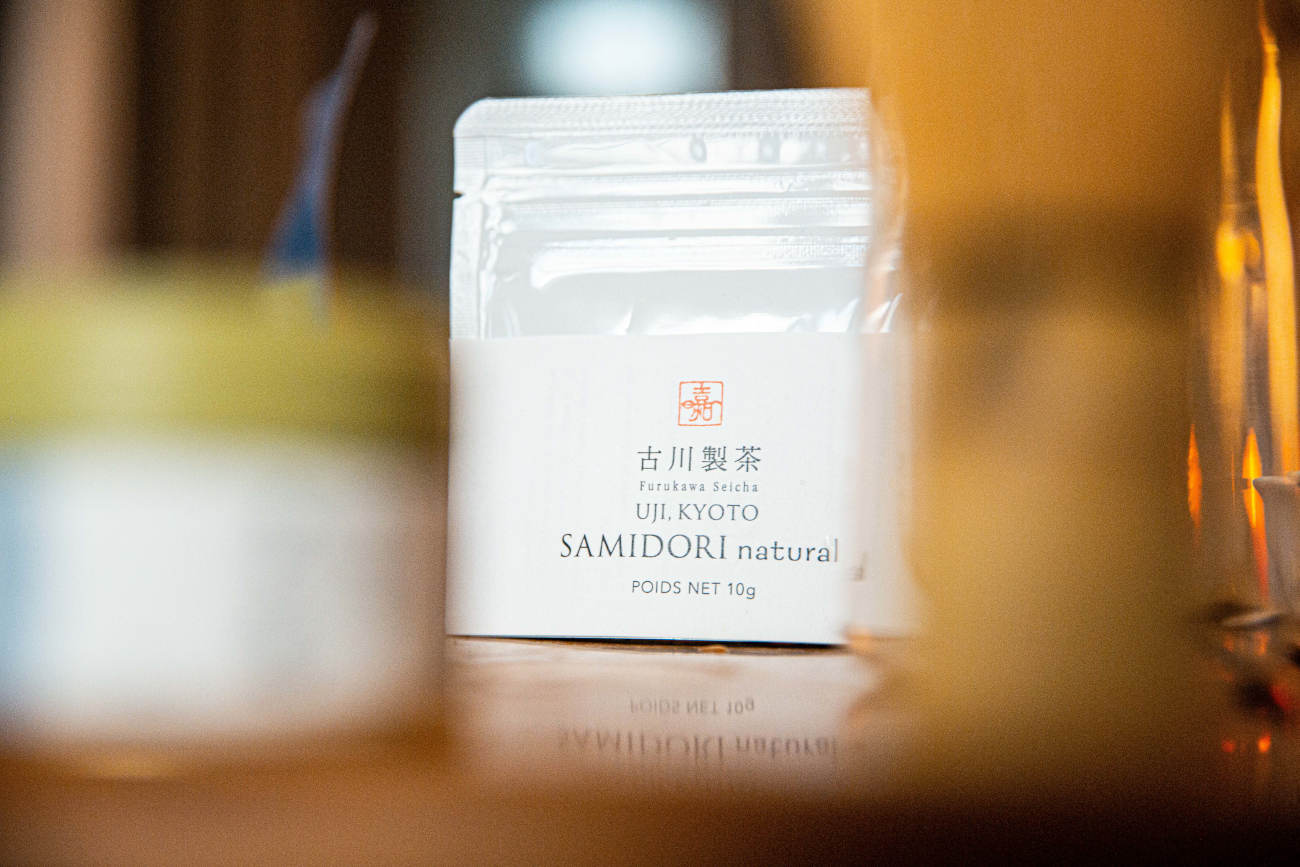
Uji Matcha
We had to put a matcha in front of Sylvain Sendra, knowing that he is very drawn to the tea ceremony: chanoyu (literally "hot water for tea"), attending sessions on visits to Tokyo or Kyoto. A follower of chadō, the "way of tea", he has espoused the four principles laid down by Sen no Rikyū, which are still relevant today and which can be translated into these words: Harmony – Respect – Purity – Tranquillity. He himself whisks the tea in the bowl with a chasen (traditional bamboo whisk).
Water at 70°C / whisked by the chef.
Mother-of-pearl spoon (the same as for tasting caviar): 2 heaped spoonfuls.
"It has a very bright green colour. It exudes bitterness and a lot of energy, because this tea is very energising. It is very nourishing. Whereas I see the healthy part more in gyokuro or hōjicha, I appreciate the comforting, almost lactic, side of matcha. It's a very bitter, frothy tea… It is appetising because, to my mind, it is a tea to be eaten. It reminds me of oysters, in its bitterness, its extremely iodized side, full of energy. It is very good, very concentrated, very fruity and even quite floral. You get notes of rose petals and some spinach notes. Ideal to be enjoyed with certain desserts and white chocolate in particular."
"I remember drinking an exceptional tea one winter in a wooden house in Kyoto, where Mr Yamashita had taken me. The old lady there performed a chanoyu and prepared matcha for us. We drank it from family bowls that were two centuries old. Once the lady told me how old the crockery was, I didn't dare touch it because I'm really clumsy. I thought the bowl was remarkable. The contents were as beautiful as the receptacle."

Genmaicha
Genmai can be translated as "brown rice", but generally the Japanese use white rice – toasted or puffed – combined with sencha or bancha tea leaves. Low in caffeine, it can be drunk hot or cold. Sylvain Sendra chose to drink it hot.
Water at 80°C / steeped for 3 min in a Japanese teapot with a lid.
"A tea that I can drink all day, in the morning or afternoon. For me, it remains a classic tea that I can drink in summer or winter, hot or cold, very comforting. It makes a nice first impression in the mouth with its vegetable and toasted rice flavours. It is the ideal accompaniment for fish such as salmon because it often has a distinct salmon skin flavour, like a taste of artichoke, Jerusalem artichoke and spinach. But I also pair it with poultry to draw out the contrasting flavours, as well as with roasted almonds."
"The pleasure is certainly the first of the benefits felt. It's worth remembering that these Japanese green teas are good for your health. A good Japanese green tea gives me a bit of a detox, much needed after holiday periods especially, in order to work off all the over-indulgence. As I have been travelling a lot lately, I feel the need to do a green tea cure – a Japanese one, first and foremost. Japan is the land of green tea."
As much a discipline as it is an art, the method of preparing a Japanese green tea is in itself a metaphor for what we expect from life. One collects oneself, empties one's head to get back to the essentials, through simple and precise gestures. Observing Sylvain Sendra's hand whisking the matcha, watching his lips reach towards each bowl cupped in his hands, one understands that, with modesty and concentration, he has achieved a certain state of fulfilment, like a comfort that fosters vital energy."It is only within the emptiness", wrote Lao Tzu, "that the essential remains."
Like any authentic drinker of Japanese green tea, Sylvain Sendra has understood that the act of tasting tea engenders two feelings: a pleasure taken in its flavour and a serenity of spirit. Japanese green tea should be drunk as an asceticism to sublimate the fundamental relationship between body and mind. The spiritual dimension of tea appears natural, of personal essence, or sometimes simply stems from the moment when one drinks it, alone or with someone else, thus provoking an aspiration to calm and reflection.
Sylvain Sendra is the chef of the restaurant Fleur de pavé.
Interview by Gilles Brochard.
More information : https://greentea-jfoodo.jetro.go.jp?utm_source=michelin&utm_medium=collab&utm_campaign=all&utm_content=article
Hero Image : The service by Gilles Brochard/ Florian Domergue












